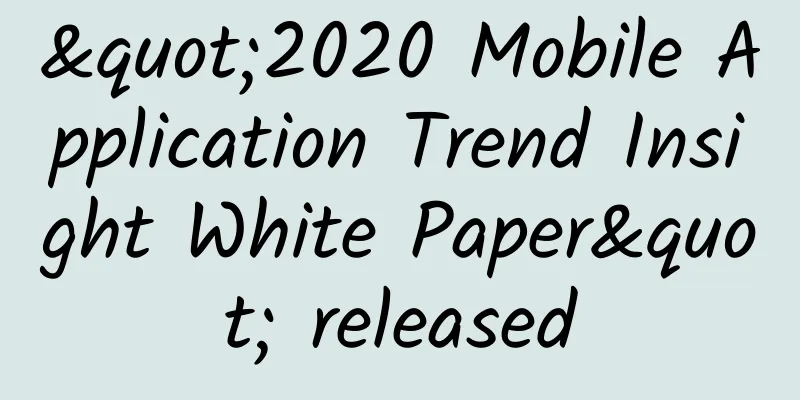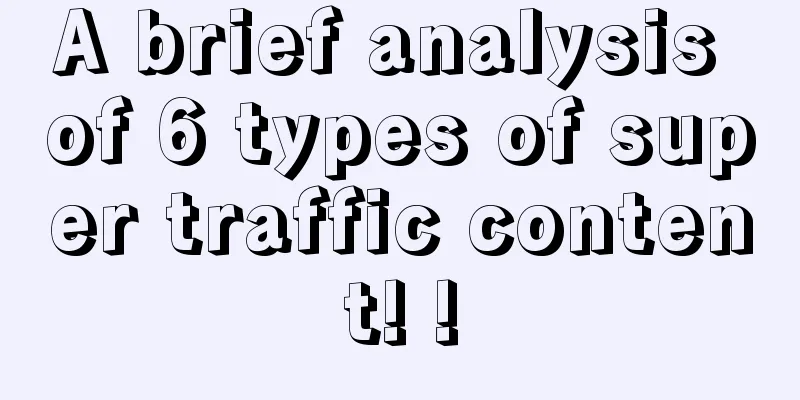"2020 Mobile Application Trend Insight White Paper" released

|
The black swan event that occurred at the beginning of the year had a profound impact on the mobile application industry. On the one hand, the epidemic restricted users' travel, and the demand for mobile applications affected the distribution scale of major global application markets; on the other hand, user habits and behaviors changed, the degree of remote cooperation in the industrial chain deepened, and new service models and concepts gradually developed. These aspects have affected the in-depth development of the mobile application industry. In addition, the lightweight application form and full-scenario intelligent application services that have long been budding have also made great progress at this stage, which have brought new development opportunities to the mobile application industry. However, opportunities and challenges often go hand in hand. Developers need to work hard to expand their application service capabilities and boundaries in order to truly grasp the development opportunities given by the times and stand out in the fierce market competition in the future. Recently, Huawei App Market and iResearch jointly released the "2020 Mobile Application Trend Insight White Paper", which contains 5 reports that provide in-depth interpretations of the overall trend of the mobile application industry, the development trends of the game industry and the education industry, developer services and product promotion, and the development of application forms. Downloads in major global app markets increased significantly, and Huawei app distribution maintained rapid growth Judging from the data performance of major global application markets, affected by the epidemic, the demand for mobile application services by global users has increased significantly. Compared with 2019, the download volume of major global application markets in Q1-Q3 2020 has increased to varying degrees, among which the download volume of Huawei Application Market (AppGallery) has increased the most significantly. Focusing on the Huawei App Market, the distribution volume of the Huawei App Market continues to maintain a high-speed growth trend. Not only is it vigorous at this stage, but it also has a lot of room for growth in the future. Analyzing the data performance in the past two years, it can be found that as of Q3 2020, the global distribution volume of the Huawei App Market has reached 294 billion, surpassing the full-year distribution scale in 2019. The special market environment affects the in-depth development of the mobile application industry, and some online scene applications have ushered in favorable development Similar to the impact of the SARS epidemic on the e-commerce industry in 2003, the epidemic has had a huge impact on the entire society, especially in the mobile application industry in terms of user usage habits and the derivative usage scenarios. These include changes in user habits, changes in the remoteness of the industrial chain, and the emergence of new service models and concepts. These three aspects have a far-reaching impact on the entire application industry. In terms of mobile application scenarios that users use more after the epidemic, according to iResearch user survey data, compared with before the epidemic, more than 50% of users will use online scenarios such as remote office, online entertainment, and online education more, which also indirectly shows that the effect of cultivating user habits in these three scenarios is more prominent. The mobile application carrier form is lightweight, and the mobile application service model is intelligent in all scenarios (1) Lightweight carrier form: The problems brought about by the changes in the mobile application industry environment have troubled many application developers, such as the disappearance of user growth dividends, super applications controlling traffic, and user application installation volume encountering bottlenecks. At the same time, the accumulation and progress of many technologies such as 5G, cloud computing, cross-end development, front-end development technology stack, Internet information processing and interaction have opened another "window" for developers, allowing lightweight applications that can smoothly experience native application services without downloading and installing to enter the public eye, and after being tested by the market and users, they have gradually formed a development situation of complementary symbiosis with native applications. For application developers, on the one hand, lightweight applications can improve user experience and improve application distribution and service efficiency; on the other hand, lightweight applications can optimize developers' computing power deployment, better adapt to smart IoT devices, and help developers grasp future development trends. (2) Full-scenario intelligence of service models: The production capacity of smart hardware is growing rapidly, and the types of hardware are constantly enriched. At the same time, the development of communication technology and the improvement of hardware performance have jointly broadened the application scenarios of smart hardware, making it possible for applications to develop across platforms and provide personalized services in combination with user scenarios. For developers, the full-scenario intelligence of service models not only expands new application service scenarios and traffic entrances, but also reduces user learning costs, improves application experience in multi-device environments, and provides developers with more commercial opportunities. In addition, the majority of developers are full of expectations for full-scenario intelligent services. According to a developer survey organized by iResearch Consulting and Huawei App Market, 80% of developers have plans to deploy full-scenario smart life services. However, in the actual operation of deploying full-scenario intelligent services, developers face multiple difficulties such as user management data, scenario services, and interactive experience. Breaking through these difficulties requires support from the underlying system platform. The full-scenario intelligent ecological structure represented by Huawei solutions starts from the underlying system platform, relies on HMS & HarmonyOS drivers, and uses Huawei App Market as a connection platform and performance acceleration and amplification platform. On the one hand, it builds an application ecosystem around users and application developers, and on the other hand, it combines "1+8+N" to create a hardware ecosystem, and ultimately promotes collaborative innovation in the fields of software and hardware. It is committed to providing better precision and personalized service content while expanding full-scenario user devices and obtaining greater traffic, and ultimately allows user needs to be intelligently matched with terminal services to achieve a seamless and high-quality full-scenario smart life experience. Mobile application developers can use the full-scenario intelligent ecosystem to gain empowerment from both the software development and software service levels. At the software development level, the hardware ecosystem layout can increase user reach and enhance monetization, and the unified data interface can also help developers achieve data interoperability between various devices and applications; at the software service level, the ecosystem layout can expand application service capabilities and bring users more personalized, precise, and high-quality services based on scenarios. Through the effective combination and performance amplification of software development and software services, a virtuous cycle of win-win situations between developers and platforms can ultimately be achieved. Mobile games, audio and video entertainment and other head applications have a leading distribution scale, while long-tail applications are still to be developed From the perspective of Huawei's global application distribution scale, the three major application types, such as mobile games (overall) and audio-visual entertainment, accounted for more than 10% of the distribution volume, leading the way. Among the long-tail applications, there are many application categories such as information reading and convenient life, while some applications that realize the digitization and onlineization of offline services, such as travel accommodation and food, still need innovation and exploration by the majority of application developers. Taking shopping comparison and games as examples, we further discovered that the top application categories showed the following development trends: Shopping price comparison: live streaming e-commerce has entered a period of rapid growth after its outbreak, and social e-commerce has become the industry's hottest topic. The Chinese e-commerce market still has a promising future; the sinking consumer market has become the industry's growth engine, which will trigger a new round of competition in the industry. However, as e-commerce services continue to become popular, the user base of the top e-commerce platforms has also continued to rise. The top platforms Taobao, Pinduoduo and JD.com together cover nearly 90% of e-commerce users. The middle and long-tail e-commerce platforms need to further differentiate themselves from the top platforms in order to gain a foothold in the industry, and the competitive pressure is relatively high. At the same time, the growth potential of live streaming e-commerce and social e-commerce is also coveted by content platforms. Based on the huge user base and smooth user operation system, content platforms have built their own e-commerce ecosystems in an attempt to form a complete closed loop, which has brought new challenges to e-commerce platforms. Mobile games: In terms of the number of games, the issuance of game licenses continues to tighten, pushing games towards full-process quality; in terms of game form, cloud games have solved the limitations of traditional large-scale games and mobile games, and will enter a period of rapid development in the future due to the support of 5G; in terms of game marketing, short videos and celebrity endorsements have become new hot spots, improving the efficiency of mobile game marketing. However, as the Chinese game market is in a critical stage of transformation and change, there are also many pain points in the industry, such as the scarcity of quality games and low user satisfaction with game-related content provided by various channels. Huawei Game Center provides corresponding solutions to the above problems to clear development obstacles for developers. For example, in view of the extreme scarcity of creative and high-quality games in the market, and the higher investment and risks in R&D and distribution, Huawei Game Center supports high-quality games in all aspects of R&D, testing, distribution, and operation to promote innovative development. In view of the high demand of game users for game-related content, Huawei Game Center distributes high-quality content through content-based and community-based actions to meet user needs and increase game exposure and user activity. In order to address the problem that the game application download and installation process affects the game conversion rate, Huawei Game Center uses fast game services to reduce user experience costs. At the same time, fast games and native applications can be seamlessly connected, giving full play to the respective advantages of fast games and native applications, helping game manufacturers to achieve new conversions. In the field of mobile applications, Huawei App Market has been committed to providing all-round services to developers, helping them explore industry trends, building service platforms, and acting as a booster for developers' growth, so as to better build a new blueprint for the vigorous development of the mobile application industry together with developers. Recently, Huawei App Market and iResearch jointly released the "2020 Mobile Application Trend Insight White Paper". The above content is only an excerpt and condensation of some chapters of the white paper. For more information, please log in to the official website of "Huawei Developer Alliance" and search for "Mobile Application Trend Insight White Paper - Overview" to view the full report. Full report link: https://developer.huawei.com/consumer/cn/doc/distribution/app/IR_ServicetWhitePaperg |
<<: In 5 days, WeChat will ban this behavior
>>: Google: Future Android phones will receive 4 years of software updates
Recommend
China's smartphone shipments fell 6% in the second quarter, with Xiaomi's sales down 20% year-on-year
Market research company Canalys today released a ...
Anqing Mini Program Development Company, how much does it cost to develop a tableware mini program?
How much does it cost to develop the Anqing table...
Record low-quality videos and upload them to major paid course platforms to earn income. Everyone can do it with low threshold
I have previously shared projects about recording...
APP operation: To make an APP from start to finish, what operations are required?
I have been working in the product field for more...
Take every step carefully and build a user growth system from scratch!
Recently, I have received a lot of inquiries abou...
Android P is officially confirmed as 9.0, and the third developer preview version has these new changes |
Recently, Google released the third developer pre...
Introduction to Baidu search promotion paid advertising!
What is Baidu search promotion Baidu search promo...
Why are brands rushing to collaborate across industries?
1. Conclusion I’m afraid you’ll think I’m being t...
Bao Juncheng: ATA All-round Literacy - Reading Chinese Stories (A)
A unique learning dimension: explaining Chinese s...
Introduction to Huawei App Market paid promotion process and resource positions!
Introduction to Huawei AppGallery Paid Promotion ...
What are the standards for masks used for the new pneumonia? What masks should be used to prevent pneumonia infection?
It has been more than 10 days since the Wuhan epi...
New media operation: revealing the real reason for the sudden increase in fans
Among various new media platforms, the most impor...
Four common methods for attracting traffic from Douban
When it comes to Douban, many people's impres...
Only 7 steps to easily build an AB test closed loop
As companies pay more and more attention to data,...
Information flow advertising creativity, 3 tricks you can’t miss!
I still remember that in September last year, 16 ...









